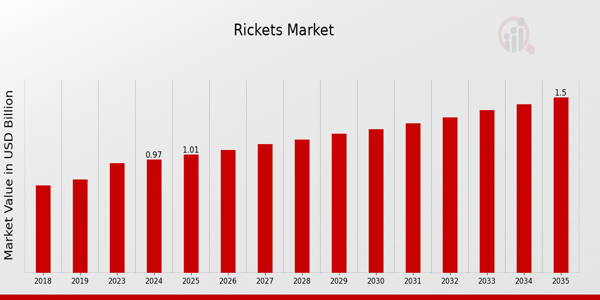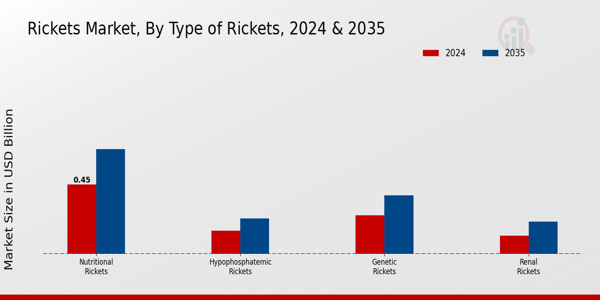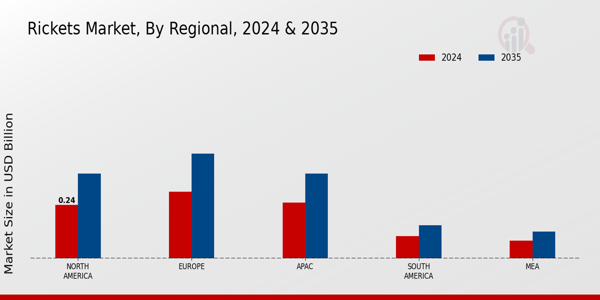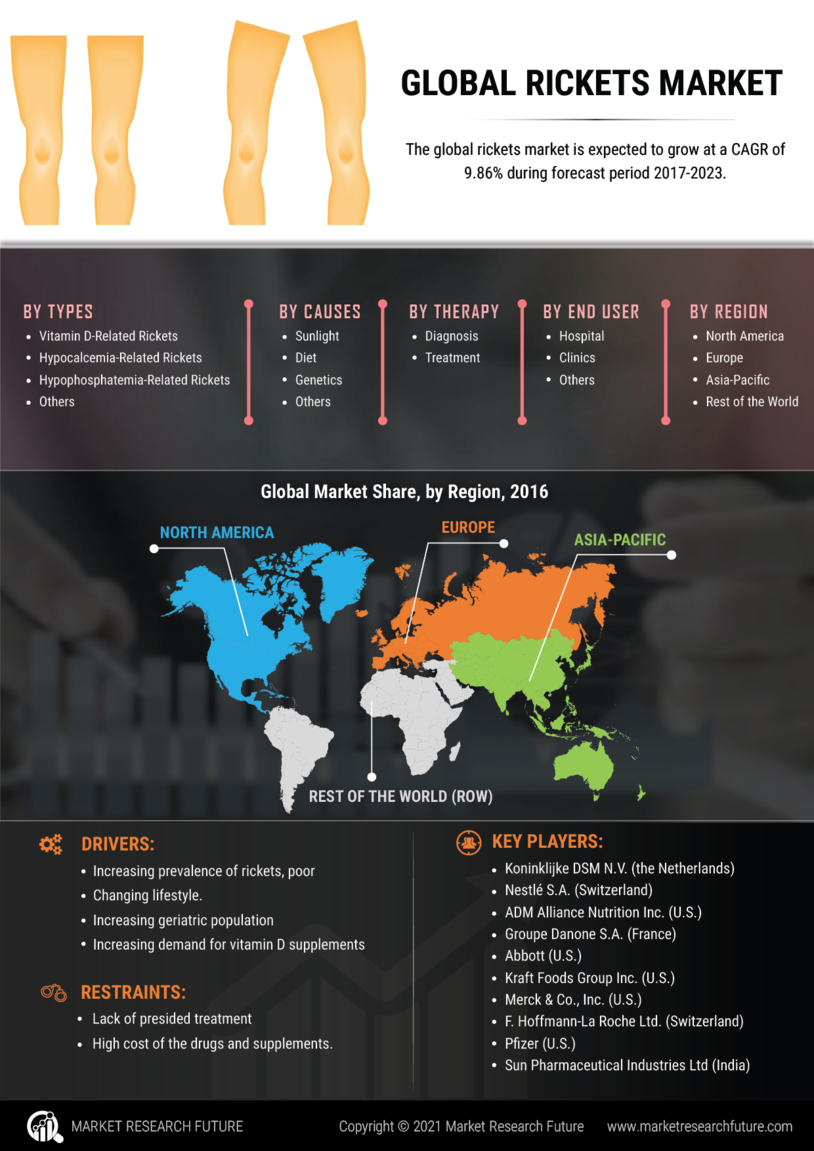Rickets Market Overview
As per MRFR analysis, the Rickets Market Size was estimated at 0.94 (USD Billion) in 2023. The Rickets Market Industry is expected to grow from 0.97(USD Billion) in 2024 to 1.5 (USD Billion) by 2035. The Rickets Market CAGR (growth rate) is expected to be around 4.01% during the forecast period (2025 - 2035).
Key Rickets Market Trends Highlighted
The Global Rickets Market is currently experiencing notable trends that reflect the increasing awareness and understanding of the disease. One of the key market drivers is the rising incidence of vitamin D deficiency, particularly in regions where populations are less exposed to sunlight. This has prompted healthcare providers and governments to prioritize nutritional education and supplementation programs to combat the condition. Awareness campaigns aimed at educating parents about the signs and symptoms of rickets are also gaining traction, thereby fostering early diagnosis and treatment options.
Opportunities to be explored include the development of fortified foods and innovative dietary supplements that target vulnerable populations, especially children.
Policies are being created to improve nutrition at the community and school level due to shifts within the government and health organizations on the importance of preventative measures. There is a new opportunity for collaboration between healthcare professionals and practitioners to design more effective health protocols into public health policies. Screening and surveillance for rickets is on the rise, which is critical in measuring its prevalence and ensuring prompt action is taken. Improved patient outcomes are being made through effective health tracking and better managed with digital health technologies.
Additionally, the integration of telehealth services has made it easier for families in remote areas to access medical advice and treatment, improving access to care. As global health initiatives continue to evolve, there is a clear direction toward comprehensive solutions that address not just treatment but also prevention and education surrounding rickets.

Source: Primary Research, Secondary Research, Market Research Future Database and Analyst Review
Rickets Market Drivers
Increasing Prevalence of Vitamin D Deficiency
The rising incidence of Vitamin D deficiency is a significant driver for the Global Rickets Market Industry. According to global health studies, it is estimated that over 1 billion people worldwide are Vitamin D deficient, with geographical variations particularly noted in regions with limited sunlight exposure. The World Health Organization suggests that this deficiency accounts for a considerable rise in rickets cases, particularly in children under five, leading to an increased demand for intervention products such as supplements and fortified foods to combat the condition.
Established organizations like the Global Vitamin D Council advocate for awareness and provide guidelines on Vitamin D intake, highlighting the necessity for addressing the deficiency at an early stage. The increasing recognition of Vitamin D's importance in children's health is expected to drive demand for rickets treatments substantially in the coming years.
Growing Awareness of Bone Health
There is a growing awareness regarding the importance of bone health, especially among parents and healthcare providers in the Global market. Initiatives led by organizations such as the International Osteoporosis Foundation promote education about nutrition and lifestyle products that enhance bone health, including adequate Vitamin D and calcium intake. The increasing media coverage and educational programs have led to heightened concern about skeletal health in children, propelling parents to seek preventive measures.
This shift in consumer behavior has spurred the demand for products addressing rickets, thus fostering growth in the Global Rickets Market Industry. Studies affirm that those who are educated about nutrition are more likely to invest in health supplements for their children, indicating a positive correlation between knowledge and market growth.
Improvements in Healthcare Infrastructure
Global improvements in healthcare infrastructure play a crucial role in expanding the Global Rickets Market Industry. Enhanced access to healthcare services and nutritional programs has been noted in various countries, leading to early diagnosis and treatment of rickets. In regions where healthcare systems have improved, such as parts of Europe and North America, the rates of rickets have shown a decline due to timely screening and the availability of supplementation.
The World Health Organization reports that investments in healthcare infrastructure have equated to a 30% decrease in rickets cases in underprivileged populations when effective screening programs are implemented. This growing healthcare accessibility is a significant driver for the market, as more individuals are able to obtain necessary treatments.
Government Policies Supporting Nutritional Initiatives
Governmental policies focusing on nutritional assessment and intervention are significantly benefiting the Global Rickets Market Industry. Several countries have introduced fortification programs for staple foods with Vitamin D to curb rickets prevalence. For example, in the United States, the FDA supports fortification regulations that enhance public health, contributing to a projected decrease in rickets cases. The global response to dietary deficiencies, particularly in childhood, reflects a collaborative effort between ministries of health and agricultural agencies to ensure accessible nutrition.
The World Health Organization emphasizes the importance of such initiatives, linking nutritional policies with health outcomes. The commitment seen in various policies globally bolsters market growth as an increasing number of families gain access to fortified products aimed at preventing rickets.
Rickets Market Segment Insights
Rickets Market Type of Rickets Insights
The Global Rickets Market demonstrates a noteworthy division within the Type of Rickets segment, illuminating varied causes and forms of this bone disorder. In 2024, the market was valued at 0.97 USD Billion, with various forms displaying distinct characteristics and economic significance. Among these, Nutritional Rickets held a notable majority holding, valued at 0.45 USD Billion in 2024, reflecting its prominence primarily due to dietary deficiencies in vitamin D, calcium, and phosphorus, which are critical for bone health, particularly in children.
Genetic Rickets followed as a significant segment, valued at 0.25 USD Billion in the same year, driven by hereditary conditions that lead to improper bone mineralization; this segment emphasizes the importance of genetics in the overall landscape of rickets. Hypophosphatemic Rickets, although smaller in comparison, commanded attention with a valuation of 0.15 USD Billion in 2024. This form, caused by renal phosphate wasting, emphasizes the necessity for awareness of kidney function and mineral balance in addressing rickets.
Meanwhile, Renal Rickets, valued at 0.12 USD Billion, highlighted a critical link between kidney health and bone formation, underlining that chronic kidney issues can lead to significant skeletal complications.
Looking forward to 2035, the Global Rickets Market is set to grow, with Nutritional Rickets anticipated to reach 0.68 USD Billion, maintaining its dominant status due to increasing awareness regarding diet and bone health. Genetic Rickets grew to 0.38 USD Billion, indicating a continued focus on research into hereditary factors influencing rickets, while Hypophosphatemic Rickets rose to 0.23 USD Billion and Renal Rickets to 0.21 USD Billion, showcasing a growing recognition of the clinical importance of these conditions.
Together, this wealth of insights contributes to a detailed understanding of the Global Rickets Market segmentation and illustrates how each type plays a critical role in shaping industry dynamics, further correlating with the Global Rickets Market revenue and statistics. Understanding these segments provides valuable context for healthcare providers and policymakers in addressing preventative measures and treatment strategies crucial to combating rickets on a global scale.

Source: Primary Research, Secondary Research, Market Research Future Database and Analyst Review
Rickets Market Age Group Insights
The Global Rickets Market, particularly when analyzed through the lens of age groups, reflects a significant dimension of the overall industry, which was valued at 0.97 Billion USD in 2024 and is projected to grow over time. This market is primarily segmented into Infants, Children, and Adolescents, with each category playing a crucial role in shaping market dynamics. Infants are particularly vulnerable given their rapid growth and development needs, necessitating a strong focus on proper nutrient intake to prevent deficiencies.
Children also represent a substantial portion of the market due to an increase in dietary deficiencies in various regions and the rising awareness regarding bone health.
Adolescents are involved as they undergo critical growth spurts and are highly influenced by lifestyle choices, making them significant targets for education and intervention strategies regarding rickets prevention. The rising occurrence of rickets, fueled by factors such as dietary habits, urbanization, and decreased exposure to sunlight, drives growth in this market segment.
As regulatory bodies continue to emphasize the importance of nutrition, the Global Rickets Market data indicates a robust demand for preventive measures, highlighting opportunities for innovations in fortified foods and public health initiatives.This segment remains a focal point for stakeholders aiming to address the rickets challenge comprehensively and effectively within the Global Rickets Market industry.
Rickets Market Diagnosis Method Insights
The Global Rickets Market is progressively evolving, particularly in the Diagnosis Method segment, which plays a crucial role in identifying and managing rickets effectively. As of 2024, the market was valued at 0.97 USD Billion, showcasing the increasing awareness and importance of early diagnosis in improving patient outcomes. The Diagnosis Method includes various approaches, such as Blood Tests, X-rays, Bone Density Scans, and Physical Examinations. Each method holds significant relevance; Blood Tests are essential for assessing vitamin D levels and other biochemical markers, directly correlating with rickets diagnosis.
X-rays provide important visual insights into bone health, aiding in detecting deformities associated with rickets. Bone Density Scans are pivotal in assessing bone fragility, which is a critical concern in rickets patients, especially in the pediatric population. Physical Examination serves as a primary assessment tool, allowing healthcare professionals to gauge clinical signs indicative of rickets.
This diverse range of diagnostic techniques highlights the market's segmentation, catering to a global audience seeking effective and efficient diagnostic solutions for rickets.Increasing investment in healthcare and the rising prevalence of rickets are further driving the market growth, establishing a stronger foundation for innovative diagnostic approaches in this niche segment of the healthcare industry.
Rickets Market Treatment Type Insights
The Global Rickets Market, particularly in the Treatment Type segment, focuses on a variety of therapeutic approaches to address this nutritional deficiency-related condition. As of 2024, the market was valued at 0.97 billion USD, showcasing its significant presence in the healthcare landscape. Among the treatment modalities, Vitamin D Supplementation plays a crucial role, recognized for its effectiveness in enhancing bone health and combating rickets symptoms. Calcium Supplementation is also vital, as it directly contributes to bone density and overall skeletal development.
Phosphate Replacement Therapy is essential for patients with specific metabolic disorders affecting phosphate metabolism, providing targeted treatment to enhance bone mineralization. Medication options, while less common, serve to address underlying pathological conditions related to rickets. The Global Rickets Market data indicates a steady increase in market growth, driven by rising awareness and diagnosis of rickets. Major challenges include accessibility to treatment and awareness in low-income regions, yet opportunities abound to enhance patient education and healthcare access globally.
The Global Rickets Market segmentation illustrates a diversified approach toward treating rickets, with each treatment type holding significant importance in improving patient outcomes and overall health.
Rickets Market Regional Insights
The Global Rickets Market exhibits significant growth across various regional segments, reflecting diverse healthcare initiatives and demographic factors. In 2024, the North America market was valued at 0.24 USD Billion, making it a dominant player in the industry with strong healthcare infrastructure and awareness, expected to reach 0.38 USD Billion by 2035. Europe followed closely, holding a market value of 0.30 USD Billion in 2024 and projected to grow to 0.47 USD Billion by 2035, driven by public health campaigns addressing nutritional deficiencies.
The APAC region was valued at 0.25 USD Billion in 2024, with growth to 0.38 USD Billion by 2035, demonstrating improving healthcare access and a growing population concerned with rickets prevention. South America was valued at 0.10 USD Billion in 2024 and is anticipated to evolve into a market worth 0.15 USD Billion by 2035, where increasing awareness of Vitamin D's importance drives growth.
Lastly, the MEA region, while smaller, had a current valuation of 0.08 USD Billion in 2024 and is projected to rise to 0.12 USD Billion by 2035, indicating growing recognition of health issues related to rickets.The variations across these regions underscore the importance of localized healthcare strategies and the growing emphasis on prevention and education in mitigating rickets prevalence.

Source: Primary Research, Secondary Research, Market Research Future Database and Analyst Review
Rickets Market Key Players and Competitive Insights
The Global Rickets Market is characterized by a growing awareness of the disease's implications and a rising demand for effective treatment options. Rickets, primarily a result of Vitamin D deficiency, has implications that extend beyond childhood health, influencing long-term bone health and overall well-being. The competitive landscape of this market is shaped by various pharmaceutical companies striving to develop innovative products, methodically enhancing their portfolios to address a pressing health issue with growing prevalence across diverse demographics.
The market is defined by significant investments in research and development, with companies focusing on expanding their therapeutic offerings while also navigating regulatory complexities and fostering collaborations to enhance distribution networks. As competition intensifies, market players are also increasingly directing efforts toward educating healthcare providers and stakeholders about prevention tactics and treatment protocols, establishing a marked presence not merely in clinical settings but also in community health initiatives.
Pfizer has established a notable presence within the Global Rickets Market through its strong portfolio of vitamin-based products designed to enhance bone health and combat deficiencies contributing to rickets. The company utilizes extensive research capabilities to develop formulations that effectively address the needs of patients. Pfizer's strengths lie in its established reputation and extensive distribution networks, which ensure that its products are readily accessible to healthcare providers.
Furthermore, Pfizer's commitment to ongoing clinical studies and collaborations with research institutions fortifies its ability to innovate continuously within the vitamin and mineral supplementation space, thereby reinforcing its position as a reliable provider for addressing rickets.
The company’s well-crafted marketing strategies and patient education initiatives allow it to reach a broader audience, enhancing awareness about rickets and the importance of early intervention.Merck and Co is another significant player in the Global Rickets Market, primarily recognized for its contribution to developing key therapeutic solutions focused on nutrient deficiencies. The company's products are tailored to ensure patients receive adequate Vitamin D, which is crucial in rickets prevention and treatment.
Merck's strengths include a robust research and development division that continuously seeks to innovate and improve treatment formulations. With an esteemed reputation for quality, Merck benefits from its established global distribution channels, making its products widely available. The company has also engaged in numerous mergers and acquisitions, which have enabled it to expand its product offerings and market reach significantly.
With its focus on public health education and community outreach programs, Merck is actively working to increase awareness about rickets across various demographics, showcasing its commitment to advancing health outcomes globally while achieving competitive advantages in the market.
Key Companies in the Rickets Market Include
- Pfizer
- Merck and Co
- AbbVie
- Roche
- Johnson and Johnson
- GSK
- Novartis
- Mylan
- Teva Pharmaceuticals
- Bayer
- Bristol-Myers Squibb
- Amgen
- Eli Lilly and Company
- Sanofi
Rickets Market Industry Developments
In recent developments, the Global Rickets Market has seen heightened activity, with several pharmaceutical companies focusing on innovative treatments and expanding their product pipelines. Notable players include Pfizer, Merck and Co., AbbVie, Roche, Johnson and Johnson, GSK, Novartis, Mylan, Teva Pharmaceuticals, Bayer, Bristol Myers Squibb, Amgen, Eli Lilly and Company, and Sanofi. The need for enhanced therapies has driven companies to invest in Research and Development as awareness regarding vitamin D deficiency and its implications on children's health increases globally, particularly in regions with limited sunlight exposure.
Recent market valuation growth indicates a rising demand for effective treatments, as many governments are emphasizing preventive healthcare measures related to bone health. Furthermore, in August 2023, AbbVie completed its acquisition of a biotechnology company specializing in osteoporosis treatments, marking significant consolidation in the sector. This move aligns with the growing focus on improving patient outcomes. Over the past few years, advancements in genetic understanding and targeted therapies have shaped the market dynamics, driving interest from both consumers and healthcare professionals in exploring therapeutic options for rickets.
Rickets Market Segmentation Insights
Rickets Market Type of Rickets Outlook
- Nutritional Rickets
- Genetic Rickets
- Hypophosphatemic Rickets
- Renal Rickets
Rickets Market Age Group Outlook
- Infants
- Children
- Adolescents
Rickets Market Diagnosis Method Outlook
- Blood Test
- X-ray
- Bone Density Scan
- Physical Examination
Rickets Market Treatment Type Outlook
- Vitamin D Supplementation
- Calcium Supplementation
- Phosphate Replacement Therapy
- Medication
Rickets Market Regional Outlook
- North America
- Europe
- South America
- Asia Pacific
- Middle East and Africa
| Report Attribute/Metric Source: |
Details |
| MARKET SIZE 2023 |
0.94(USD Billion) |
| MARKET SIZE 2024 |
0.97(USD Billion) |
| MARKET SIZE 2035 |
1.5(USD Billion) |
| COMPOUND ANNUAL GROWTH RATE (CAGR) |
4.01% (2025 - 2035) |
| REPORT COVERAGE |
Revenue Forecast, Competitive Landscape, Growth Factors, and Trends |
| BASE YEAR |
2024 |
| MARKET FORECAST PERIOD |
2025 - 2035 |
| HISTORICAL DATA |
2019 - 2024 |
| MARKET FORECAST UNITS |
USD Billion |
| KEY COMPANIES PROFILED |
Pfizer, Merck and Co, AbbVie, Roche, Johnson and Johnson, GSK, Novartis, Mylan, Teva Pharmaceuticals, Bayer, BristolMyers Squibb, Amgen, Eli Lilly and Company, Sanofi |
| SEGMENTS COVERED |
Type of Rickets, Age Group, Diagnosis Method, Treatment Type, Regional |
| KEY MARKET OPPORTUNITIES |
Increasing prevalence of vitamin D deficiency, Growing awareness of preventive healthcare, Expansion of supplementation programs, Development of targeted therapies, Rising demand for nutritional fortification |
| KEY MARKET DYNAMICS |
rising prevalence of vitamin D deficiency, increasing awareness about bone health, growing pediatric population, advancements in medical research, government health initiatives |
| COUNTRIES COVERED |
North America, Europe, APAC, South America, MEA |
Rickets Market Highlights:
Frequently Asked Questions (FAQ):
The Global Rickets Market is expected to be valued at 0.97 USD Billion by the year 2024.
By 2035, the Global Rickets Market is projected to reach a value of 1.5 USD Billion.
The expected CAGR for the Global Rickets Market from 2025 to 2035 is 4.01%.
By 2035, North America is projected to have the largest market share, valued at 0.38 USD Billion.
Nutritional Rickets is expected to be valued at 0.45 USD Billion in 2024.
The market value of Genetic Rickets is projected to be 0.38 USD Billion by 2035.
Key players in the Global Rickets Market include Pfizer, Merck and Co, AbbVie, and Roche.
Hypophosphatemic Rickets is expected to be valued at 0.15 USD Billion in 2024.
By 2035, the market value for South America in the Global Rickets Market is expected to be 0.15 USD Billion.
The Global Rickets Market faces challenges related to awareness and healthcare access while presenting opportunities for growth in emerging markets.


















